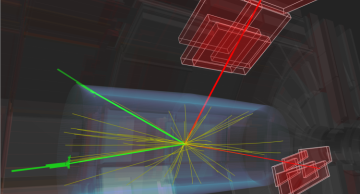A primary goal of the Large Hadron Collider (LHC) is to hunt for evidence of beyond the Standard Model (BSM) dynamics through deviations from the Standard Model (SM) predictions. If the mass of BSM particles exceeds the energy accessible in…
With the discovery of the Higgs boson in 2012, an important piece in our puzzle to understand the Universe was found. However, there are still many open questions: why is the Higgs boson so light? What is dark matter? How does gravity work at…
The Higgs boson is a fascinating elementary particle, and its discovery twelve years ago cemented the standard model (SM) of particle physics as the most accurate description of nature at and below the electroweak energy scale. However, many…
At the LHC, lead ions are smashed together at extremely high speeds to create a unique state of matter called the quark gluon plasma. Normally, quarks and gluons, such as those that make up lead ions, are confined within protons and neutrons…
In the world of elementary particles, there are twelve generic types of fermions (spin ½ particles): 3 up-type quarks, 3 down-type quarks, 3 charged leptons, and 3 neutrinos. They come in three generations. The number “3” is really a magic…
Since the discovery of the Higgs boson in 2012, scientists have been on an epic quest to measure its properties and hunt for any clues that might reveal new physics beyond the Standard Model (SM). One of the main studies consists of counting…
The CMS Collaboration at CERN has conducted an analysis to explore the differences between tau leptons and muons, the two heavier cousins of the electron, and both also fundamental particles in the Standard Model (SM) of particle physics.…
The term "Dark Matter" was coined in 1933 by Fritz Zwicky. While studying the Coma galaxy cluster, he observed that the galaxies were moving too fast to be bound by the visible mass alone. He concluded that something else, something invisible…
A principal goal of the LHC and its high-luminosity upgrade is measuring the Higgs boson interaction with itself. Observing the production of pairs of Higgs bosons is the best way of experimentally establishing this and other Higgs boson…
A particle compatible with the Higgs boson of the standard model (SM) was observed in 2012 by the ATLAS and CMS Collaborations, with a mass of about 125 GeV. Could there be other heavier Higgs bosons, as predicted in some theories trying to…
The 2012 discovery of the Higgs boson at the CERN LHC was a milestone confirmation of the Standard Model, a theoretical framework that describes all the known elementary particles – the fundamental building blocks of our universe – and their…
Our current understanding of the nature of elementary particles and their interactions is encapsulated in what is known as the Standard Model (SM) of particle physics. Particles and interactions introduced in the SM have been measured with…












